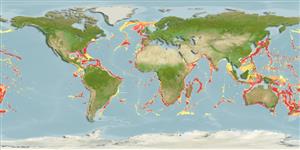分类 / Names
俗名 | 同种异名 | Catalog of Fishes(属, 种) | ITIS | CoL | WoRMS | Cloffa
Elasmobranchii
板鳃亚纲 (鲨鱼与 鱼) (sharks and rays) >
Carcharhiniformes (Ground sharks) >
Pseudotriakidae (False catsharks)
Etymology: Pseudotriakis: pseudo-, from pseudes (Gr.), false, i.e., although this genus may superficially resemble Triakis (Triakidae), such an appearance is false. (See ETYFish); microdon: micro-, from mikros (Gr.), small; odon (Gr.), tooth, referring to numerous small teeth (>200 rows in each jaw). (See ETYFish).
Environment: milieu / climate zone / depth range / distribution range
生态学
海洋 深海底的; 深度上下限 173 - 1890 m (Ref. 58302). 深水域; 64°N - 48°S, 98°W - 153°W
Western Atlantic: New York and New Jersey, USA. Reported from Cuba (Ref. 26340); including Brazil (Ref. 53443). Northeast Atlantic: Atlantic slope off Iceland, France, Portugal, Madeira, Azores, Senegal, and Cape Verde. Indian Ocean: Aldabra Island group and Western Australia (Ref. 13565). Pacific Ocean: Japan, Taiwan, New Zealand, and Hawaii (Ref. 13565).
西大西洋: 纽约与美国的纽泽西。 记录来自古巴了;(参考文献 26340) 包括巴西。 (参考文献 53443) 东北大西洋: 大西洋斜坡外海的冰岛,法国,葡萄牙,马得拉群岛,亚速群岛,塞内加尔与维德角。 印度洋: 亚达伯拉岛群与西澳大利亚.(参考文献 13565) 太平洋: 日本,台湾,纽西兰与夏威夷.(参考文献 13565)
Length at first maturity / 大小 / 重量 / 年龄
Maturity: Lm 253.5, range 210 - 295 cm
Max length : 269 cm TL 雄鱼/尚未辨别雌雄; (Ref. 244); 295.0 cm TL (female)
简单描述
检索表 | 型态特徵 | 形态测量图
背棘 (总数) : 0; 臀棘: 0. Lower lobe of caudal fin hardly developed, its upper edge not rippled and a subterminal notch present (Ref. 13565). Uniformly dark brownish-grey, darker on posterior edges of pelvic, dorsal, anal and caudal fins (Ref. 13565).
尾鳍下叶刚刚发展, 它的上缘不使与起涟漪一个接近端位的凹槽呈现.(参考文献 13565) 全深褐灰色, 比较深色的在腹鳍,背鳍、臀鳍与尾鳍的后缘上.(参考文献 13565)
Found on the continental and insular slopes, occasionally wandering onto continental shelves (Ref. 13565). Inactive and sluggish (Ref. 13565). Probably eats bony fishes, elasmobranchs and invertebrates (Ref. 244). Ovoviviparous, embryos feeding on yolk sac and other ova produced by the mother, uterine milk is consumed additionally (Ref. 50449). Pups number 2 to 4 in a litter (Ref. 244), size at birth between 70 (Ref. 244) and 140 cm TL (Ref. 13565). Caught very rarely by deepwater demersal longline fisheries in some areas. Utilized for its fins (limited value), meat and cartilage (Ref.58048).
栖息于大陆斜坡与岛屿斜坡了, 偶然徘徊在大陆棚之上.(参考文献 13565) 不活跃而缓动性的.(参考文献 13565) 可能吃硬骨鱼类,板鳃类与无脊椎动物。 (参考文献 244) 卵胎生的, 胚胎吃卵黄囊与其他的卵产生于母亲了, 子宫分泌的乳汁附加地被消费.(参考文献 50449) 2 到 4 号幼胎一胎 (参考文献 244), 在 70(参考文献 244) 和 140 之间出生时大小公分TL.(参考文献 13565) 没有渔业利用的记录.(参考文献 13565)
Exhibit ovoviparity (aplacental viviparity), embryos feed on yolk and ova, also consume uterine milk (Ref. 50449) with 2-4 young in a litter (Ref. 13565; Ref.58048). Size at birth between 70 and 85 cm (Ref. 26346 reports it at about 140 cm TL). Distinct pairing with embrace (Ref. 205).西大西洋: 纽约与美国的纽泽西。 记录来自古巴了;(参考文献 26340) 包括巴西。 (参考文献 53443) 东北大西洋: 大西洋斜坡外海的冰岛,法国,葡萄牙,马得拉群岛,亚速群岛,塞内加尔与维德角。 印度洋: 亚达伯拉岛群与西澳大利亚.(参考文献 13565) 太平洋: 日本,台湾,纽西兰与夏威夷.(参考文献 13565)
Compagno, L.J.V., 1984. FAO Species Catalogue. Vol. 4. Sharks of the world. An annotated and illustrated catalogue of shark species known to date. Part 2 - Carcharhiniformes. FAO Fish. Synop. 125(4/2):251-655. Rome: FAO. (Ref. 244)
人类利用
渔业: 自给性渔业
工具
特别资料
下载 XML
网络资源
Estimates based on models
Preferred temperature (Ref.
123201): 4.8 - 12.7, mean 8.2 °C (based on 793 cells).
Phylogenetic diversity index (Ref.
82804): PD
50 = 1.0625 [Uniqueness, from 0.5 = low to 2.0 = high].
Bayesian length-weight: a=0.00047 (0.00023 - 0.00095), b=3.29 (3.10 - 3.48), in cm total length, based on LWR estimates for this species & (Sub)family-body (Ref.
93245).
营养阶层 (Ref.
69278): 4.3 ±0.5 se; based on diet studies.
回复力 (Ref.
120179): 非常低的, 最小族群倍增时间超过14 年 (K=0.17; Fec=2).
Fishing Vulnerability (Ref.
59153): Very high vulnerability (90 of 100).
